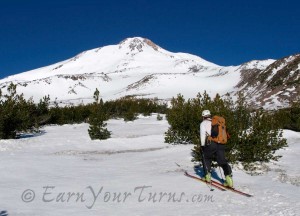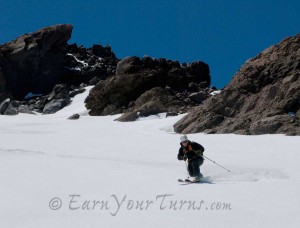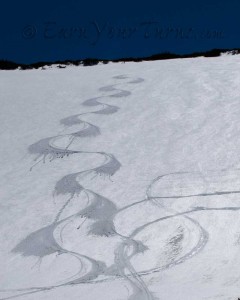I was finally able to demo the TTS binding on a recent ski trip to Mt. Shasta in June. Craig kindly set me up with the system (utilizing La Sportiva’s RT Tech toe pieces) mounted on 177 La Sportiva GT skis (123/89/111, R=22M, 6lb/pair). I don’t know what the weight was for the binding and skis together, but it felt very airy for a mid-fat setup, especially so when paired with my Scarpa F1 bellowed AT boots.

The Telemark Tech System v2 w/ La Sportiva RT Tech Toe, G3 springs.
The heel lever, climbing post, cable bar and posts are TTS unique.
It took just a few strides for me to become fully enamored with the uphill capabilities of the binding system. Having never used Dynafits before, I was instantly smitten. I have been using free-pivoting telemark bindings for many years now for nearly all my backcountry tours (aside from those taken on low, light boots and 3-pins). I know well the benefits of resistance-free boot rotation for climbing. Somehow this system was different, and better. For reference, I typically tour on Scarpa T1s and Voile Switchbacks, and I have also logged many miles in Scarpa T2X and Garmont SynerG boots.
The TTS/GT/F1 system I tried out was very light, but I think there were some other key factors at play that made it tour so well. Boot compatibility is one of those. TTS opens up the possibility of making tele turns in bellowed boots with tech fittings like F1s, F3s (unfortunately now discontinued), or any of the NTN boots with tech fittings. Some of the TTS-compatible boot choices, in addition to being relatively light, also have superior cuff range of motion for touring compared to 75mm boot offerings. Being able to tap into a hopefully growing selection of tech-fitted light boots with smooth cuff rotation is one of the unique benefits of TTS. I also like the location of the touring pivot point with the TTS. It is further back with respect to your foot than the pivots on either the Switchbacks or Silvretta Telemark Adapters that I am more accustomed to. For me this translated into a more natural, efficient, and faster stride, again something Dynafit users have known first hand for years.
If TTS has significant negative traits with respect to climbing, I did not find any. At times I would have liked a taller climbing wire than the one on my demo setup, but it looks like the manufacturer now offers a dual climbing post heel riser. (Editors note: The taller climbing wire was not installed as I am an avowed proponent of low angle skin tracks, and low or no climbing posts 
I was quick to form a positive impression of TTS for climbing, but I think I will need some more days spent in various snow conditions to adequately assess the downhill chops of the system. My initial impressions regarding the down are favorable, however. The snow our party encountered the day I tried the system out varied from a very challenging & unpredictable semi-breakable crust to great corn to wet slop.
In the challenging crusty snow I used parallel turns. I tried to smoothly drop a knee or two in the crusty stuff, but in the end just gave up on that and ripped P-turns instead. It seemed to me that TTS has more of an “all or nothing” feel with respect to dropping the knee than 75mm gear has, at least the 75mm gear that I am used to. I surmise that this may be due to rapid spring engagement of TTS when you lift your heel, even on the least active setting. There is little vertical play or slop in the system, so it pays to commit to your tele turn early, and if you don’t you may get spanked. When you lift your heel the ski tip gets driven accordingly and quickly, for better or if you’re not prepared, for worse.
Laterally, The TTS binding is precise and powerful, with great edging. I did not notice any side to side slop. The ski feels well connected to the binding and boot. Though I did revert to parallel turns more than I wanted to at times, the system pulled them off powerfully. With some time to adjust muscle memory to TTS, I think tele turns would come more naturally in all conditions.
Once we got lower on Shasta and the firm crust yielded to softer corn, I was able to take tele turns much more easily (of course). With the give of softer snow, the spring progression felt similar to the 75mm norm tele bindings I am more accustomed to.
I am fully sold on the uphill capabilities of TTS after just one demo. From what I gleaned of my short time on them, they seem like strong downhill performers as well. If the TTS proves to be durable in the long run, I think it will be the go-to binding choice for many tele skiers across both the backcountry and resort spectrums. For big days with lots of climbing and challenging descents, it sure seems to me like the best binding out there for tele skiers right now.
© 2012




10 pings
Skip to comment form
[…] in a tech binding? Yes, I used the La Sportiva toe as the front half of a Telemark Tech Systembinding. Pinheads never follow the rules and the main piece of info locked heelers can glean from […]